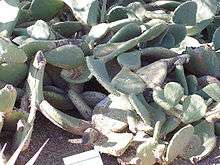Opuntia rastrera
| Opuntia rastrera | |
|---|---|
 | |
| Scientific classification | |
| Kingdom: | Plantae |
| (unranked): | Angiosperms |
| (unranked): | Eudicots |
| (unranked): | Core eudicots |
| Order: | Caryophyllales |
| Family: | Cactaceae |
| Genus: | Opuntia |
| Species: | O. rastrera |
| Binomial name | |
| Opuntia rastrera F. A. C. Weber | |
Opuntia rastrera is a prickly pear which grows in the Mexican state of San Luis Potosí.[1] It is known in Spanish as cuija,[2] although that name can also refer to other cactuses such as Brasiliopuntia.
Description
Opuntia rastrera can be found in bajada, hill-piedmont, and interdune habitats in locations such as the Mapimi biosphere reserve, where it is sometimes the most common cactus in a given location, or sometimes a secondary cactus.[3]
Propagation
In order to germinate, the seeds require a dormancy period of at least a year. As with other Opuntia species, mechanical or chemical scarification does not seem to help.[4]
The species can reproduce either vegetatively or by seed. In fact, the nature of the habitat determines which is more common, with sexual reproduction dominating in grasslands and vegetative propagation dominating in scrublands.[5]
References
- ↑ Edward F. Anderson (2001). The Cactus Family. Timber Press. p. 515. ISBN 0-88192-498-9.
- ↑ "Opuntia rastrera". NPGS/GRIN. Retrieved 2008-01-27.
- ↑ Palleiro, N., Mandujano, M. C., Golubov, J. (2006). "Aborted fruits of Opuntia microdasys (Cactaceae): insurance against reproductive failure". American Journal of Botany. 93 (4): 505–511. PMID 21646210. doi:10.3732/ajb.93.4.505.
- ↑ M.C. Mandujanoa, C. Montañab & M. Rojas-Aréchiga (July 2005). "Breaking seed dormancy in Opuntia rastrera from the Chihuahuan desert". Journal of Arid Environments. 62 (1): 15–21. doi:10.1016/j.jaridenv.2004.10.009.
- ↑ The Relative Contributions of Sexual Reproduction and Clonal Propagation in Opuntia rastrera from Two Habitats in the Chihuahuan Desert, Maria del Carmen Mandujano, Carlos Montana, Ignacio Mendez, Jordan Golubov, The Journal of Ecology, Vol. 86, No. 6 (Dec., 1998), pp. 911-921.